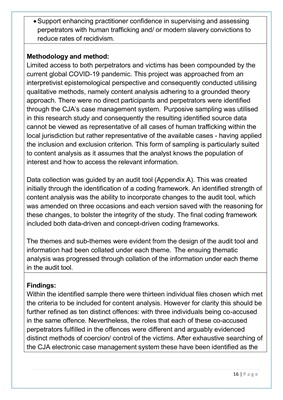
16 | P a g e
Support enhancing practitioner confidence in supervising and assessing
perpetrators with human trafficking and/ or modern slavery convictions to
reduce rates of recidivism.
Methodology and method:
Limited access to both perpetrators and victims has been compounded by the
current global COVID-19 pandemic. This project was approached from an
interpretivist epistemological perspective and consequently conducted utilising
qualitative methods, namely content analysis adhering to a grounded theory
approach. There were no direct participants and perpetrators were identified
through the CJA's case management system. Purposive sampling was utilised
in this research study and consequently the resulting identified source data
cannot be viewed as representative of all cases of human trafficking within the
local jurisdiction but rather representative of the available cases - having applied
the inclusion and exclusion criterion. This form of sampling is particularly suited
to content analysis as it assumes that the analyst knows the population of
interest and how to access the relevant information.
Data collection was guided by an audit tool (Appendix A). This was created
initially through the identification of a coding framework. An identified strength of
content analysis was the ability to incorporate changes to the audit tool, which
was amended on three occasions and each version saved with the reasoning for
these changes, to bolster the integrity of the study. The final coding framework
included both data-driven and concept-driven coding frameworks.
The themes and sub-themes were evident from the design of the audit tool and
information had been collated under each theme. The ensuing thematic
analysis was progressed through collation of the information under each theme
in the audit tool.
Findings:
Within the identified sample there were thirteen individual files chosen which met
the criteria to be included for content analysis. However for clarity this should be
further refined as ten distinct offences: with three individuals being co-accused
in the same offence. Nevertheless, the roles that each of these co-accused
perpetrators fulfilled in the offences were different and arguably evidenced
distinct methods of coercion/ control of the victims. After exhaustive searching of
the CJA electronic case management system these have been identified as the